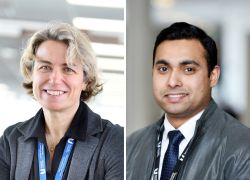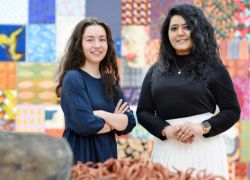Fashion – an investigator’s friend
Tattoos and piercings are very visible signs of 21st century fashion – and they’ve proved to be vital investigative tools – particularly identifying bodies in war zones and natural disasters.
It was the devastation wreaked by the Asian tsunami four years ago that highlighted the challenges of identifying bodies in horrendously-difficult conditions.
Excavation of mass graves That message was further emphasised by the excavation of mass graves after the bitter Kosovo conflict of the early 2000s, where many bodies were impossible to recognise because they had decomposed so much.
Those events have a particular resonance with University of Teesside researcher Dr Tim Thompson, a forensic anthropologist, who was called in to help identify corpses during both incidents.
His experiences in Thailand and Kosovo, as well as his work helping British police forces, have led to a project, funded by the Leverhulme Trust, that may make the process easier.
At the heart of the pioneering work are some of the most visible signs of 21st-century life. Tattoos and piercings may be cosmetic adornments, the accoutrements of the rich and famous which find an echo in the lives of young people the world over, but they can also be vital investigative tools.
One of only nine accredited forensic anthropologists The three-year study led by Dr Thompson, of the School of Science & Technology, will focus on forensic traces left behind by the cosmetic procedures. Dr Thompson is one of only nine accredited forensic anthropologists in Britain, which is why he is regularly called in to help police forces across the world.
He said, 'Forensic anthropologists are only called in when the bodies are in such a condition that identification is very difficult. In those situations, you are looking for anything which will help you put a name to the person.
'When I was sent to Thailand to help identify bodies after the Asian tsunami, the humidity meant that many of the bodies were in an advanced state of decomposition. Another problem was the sheer number of bodies.
Tattoos are important tools 'My job was to match evidence from corpses which had been recovered to records of people who had gone missing. Tattoos were important tools because even after the top and second layers of the skin have sloughed off, the tattoo remains, and actually becomes clearer.
'Similar identifying marks were also useful in Kosovo, where mass graves were being excavated. Some bodies had been there for some time and were very decomposed so we had to rely on whatever evidence remained. We were able to match some bodies to identities and, although it is very hard work and very tiring, it can be very rewarding when that happens.
'You have to divorce the fact that this is a person from the task in hand. Having said that, in Kosovo there were children's bodies, which made it particularly hard for those with children of their own.'
His belief that there was a need to explore new ways of identification was strengthened through helping police identify corpses in the UK. In cases where bodies remain undiscovered for weeks or even months, identification can be difficult and things like tattoos and piercings can be useful in matching the evidence to missing persons.
The idea for researching traces left by cosmetic procedures first cropped up when he was at the University of Dundee and he and a colleague wrote a chapter on the subject for a book.
£50,000 project Now, he is working with University of Teesside PhD student Alex Starkie on the £50,000 project, and says, 'Tattoos and piercing, and other cosmetic procedures, leave evidence behind which can be useful to investigators.
'Take the case of a dismembered corpse. We know that the chemicals from inks used in tattoos can migrate to the lymph nodes. That means they show traces in the armpits, even if the arms have been removed.
'That could help police track down the manufacturer of the ink, which would give investigators a start in identifying the body. Some manufacturers use 42 different colours. That has encouraged us because it suggests you may be able to narrow down inks found in tattoos on bodies to specific manufacturers.
'We will also examine piercing. We want to find out how long DNA stays on earrings and similar piercings. It could provide the evidence that helps with identification.'Dr Thompson will also be running a nationwide survey on the use of tattoos and piercing in forensic body identification.
 Teesside University academics join prestigious network of
...
Teesside University academics join prestigious network of
... Curatorial studies culminating with international art
...
Curatorial studies culminating with international art
... Teesside animation graduates receive top regional Royal
...
Teesside animation graduates receive top regional Royal
...